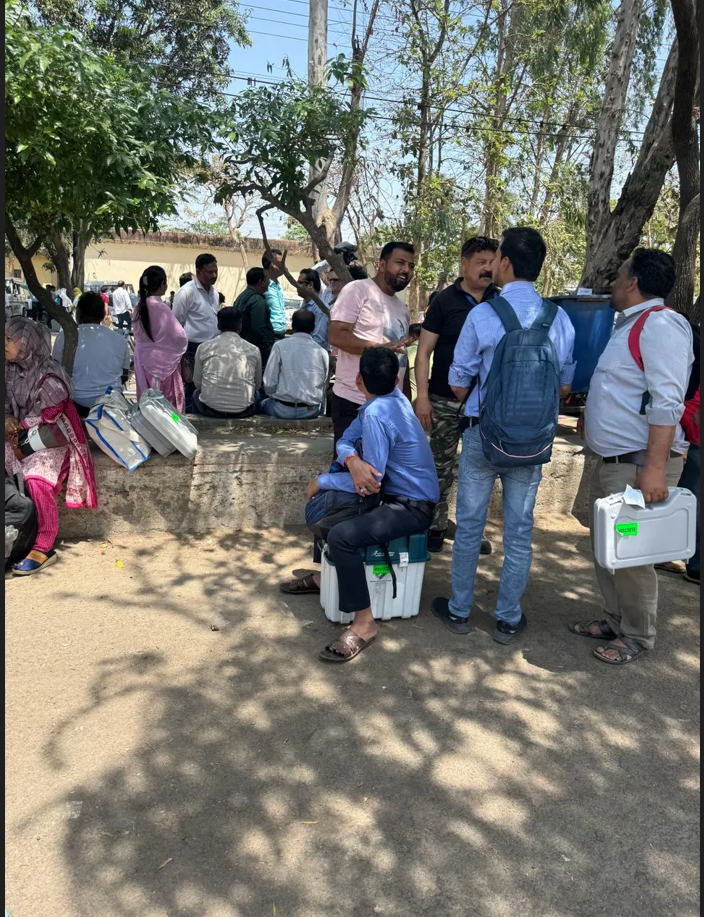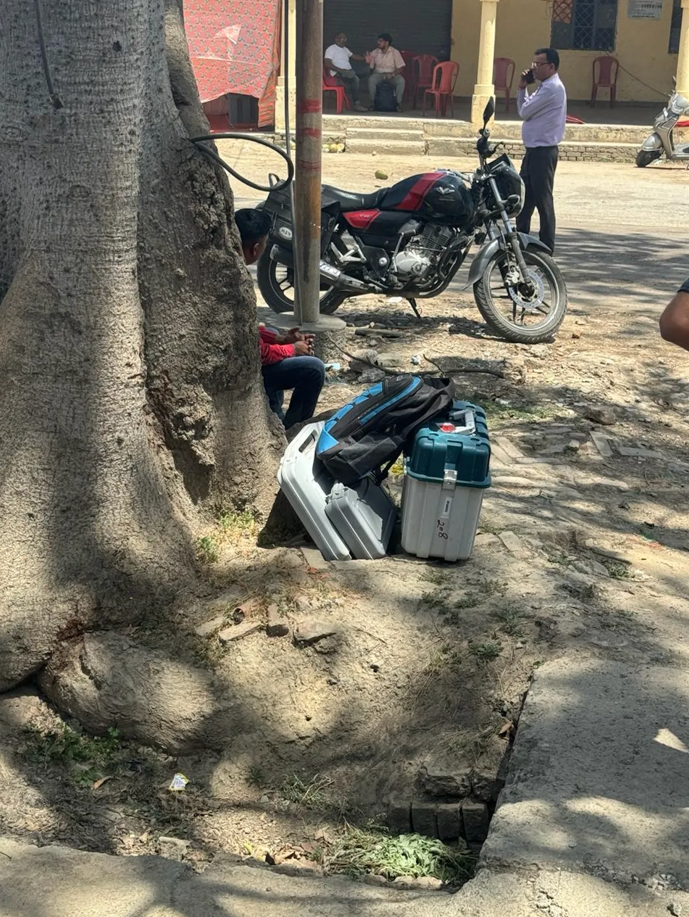General Elections 2024: Grave Lapses in Election Security | Evidence Unveiled
In a series of disturbing revelations, the integrity of the recent general elections has come under intense scrutiny. Footage exclusively accessed by The Probe exposes a shocking level of negligence and protocol breaches surrounding the handling and transportation of Electronic Voting Machines (EVMs) and Voter Verified Paper Audit Trail (VVPAT) machines.
One particularly alarming scene shows a VVPAT machine being used as a makeshift chair. Despite manufacturers’ assurances of their durability, these machines are increasingly malfunctioning, exposing a troubling reality of their mistreatment.

Another disturbing image depicts an abandoned EVM left beneath a tree, a clear violation of the strict protocols designed to safeguard these crucial devices. Such neglect not only breaches established procedures but also raises serious concerns about the security and reliability of our electoral system.

Another footage reveals polling parties transporting EVMs with shocking carelessness. In many cases, the outer covers of VVPAT machines are visibly damaged and inadequately secured during transportation. This alarming casualness could jeopardise the entire electoral process, with potential damage to the machines or even their disappearance.
The unsettling footage was accessed by senior lawyer Mehmood Pracha, who contested the elections from Rampur Lok Sabha constituency in Uttar Pradesh. Following the elections held on April 19, Pracha requested comprehensive videography and CCTV footage related to the electoral process from the District Election Officer. His efforts to obtain footage from various parts of the country are ongoing, but the Rampur footage has already unveiled significant lapses.
One particularly troubling clip shows an open truck, used for transporting EVMs and VVPAT machines, which starkly contrasts with the Election Commission of India’s (ECI) manual requirements. According to the ECI’s guidelines, such machines should be transported in containerised or sealed trucks with proper locking mechanisms. Instead, the footage reveals an open truck, lacking a roof and covered with sheets that are visibly torn, providing inadequate protection for the sensitive equipment.
Mehmood Pracha, who provided this footage, expresses his frustration: “My entire exercise has been to expose that the ECI has lied to the Supreme Court and to the world about their adherence to protocols. They claim rigorous adherence makes EVMs safe, not due to the machines themselves but because of their protocols. We aim to reveal that this is a blatant lie.”
Pracha further talks about the Symbol Loading Unit, an aspect of the election process that has not been disclosed in complete detail to the public. “This is the first time people are seeing this, and it is absent from the Election Commission’s manual,” Pracha notes.
General Elections 2024: Unveiling Flaws in Election Equipment Handling
A Closer Look at the Symbol Loading Unit
The Symbol Loading Unit (SLU) is a critical device used to upload candidate names and symbols onto VVPAT machines. Voters are familiar with the three units at the polling booth—the EVM control unit, the ballot unit, and the VVPAT printer—but the SLU, while not used during voting, is essential for preparing the VVPAT machines with the essential candidate information. The proper storage and transportation of the SLU are crucial to ensuring a smooth electoral process.
The footage provided by the ECI shows Mehmood Pracha engaging in a conversation with a BEL engineer who was responsible for assisting Election Commission officials in Rampur. The engineer’s duties included commissioning the voting machines and loading symbols into the VVPAT machines using the SLU. Pracha seeks detailed insights into the SLU’s functions and operations.
Mehmood Pracha: “Now tell me, what is this device?”
BEL Engineer: “SLU. Symbol Loading Unit.”
Mehmood Pracha: “So this unit contains the symbols.”
BEL Engineer: “Yes.”
Mehmood Pracha: “Where did this SLU come from?”
BEL Engineer: “Moradabad.”
Mehmood Pracha: “It was pre-loaded. Who loaded it and provided it to you?”
BEL Engineer: “The ECI.”
Mehmood Pracha: “The Election Commission of India loaded and provided this to you?”
BEL Engineer: (nods in affirmation)
Mehmood Pracha: “Where and how was it handed over to you?”
BEL Engineer: “From Moradabad.”
Mehmood Pracha: “But the symbols were not loaded in front of you, correct?”
BEL Engineer: “No, it was already loaded.”
Mehmood Pracha: “You received it already pre-loaded?”
BEL Engineer: “Yes.”
Mehmood Pracha: “Was it sealed? You have brought the SLU in an opened condition. Was it sealed when it was handed over to you from Moradabad?”
BEL Engineer: “It came in a box.”
Mehmood Pracha: “But it arrived open, right? Show me the box. I need to see the box. The SLU also does not have any seal, right? You expect me to believe it came from Moradabad just because you say so, correct? Show me the box.”
BEL Engineer: “This is the box.”
Mehmood Pracha: “This box has no seal. It is clearly unsealed. Anyone could open and close it easily. This is how the Symbol Loading Unit is being transported—unsealed and accessible.”
The footage and testimonies reveal critical flaws in the handling and transportation of election equipment, undermining confidence in the electoral process’s security. The failure to adhere to established protocols exposes the dire need for stringent measures to ensure the integrity of our democratic systems.
General Elections 2024: Secrecy and Negligence
Why is the Symbol Loading Unit arriving in unsealed boxes? Despite the Election Commission of India providing basic information about the SLU on its website, comprehensive details about the SLU manual—from its manufacture to deployment—remain elusive. RTI interventions led by activist Venkatesh Nayak of the Commonwealth Human Rights Initiative (CHRI) have sought this information from Bharat Electronics Limited (BEL) and Electronics Corporation of India Limited (ECIL), but requests have been denied.
The ECI’s response to RTI queries has been less than transparent. When asked for details about the SLU from the 2019 Lok Sabha elections, ECIL invoked Sections 8(1)(a) and 8(1)(d) of the RTI Act of 2005. Section 8(1)(a) protects information that could harm national security or strategic interests, while Section 8(1)(d) covers commercial secrets that could affect competitive business interests. This raises questions: why is there such secrecy surrounding the SLU manual and basic information? Shouldn’t this critical information be made available to the public?

The lack of reference material for monitoring SLU protocols means that engineers’ actions go unchecked, raising concerns about potential tampering and defects. With the EVMs and VVPATs—already known to suffer from defects—there is a valid concern that SLUs might also be prone to similar issues. Given the history of problems with EVMs and VVPATs, assuming the SLUs are flawless is unrealistic. Therefore, greater transparency from the Election Commission of India is essential.
Recent visuals illustrate further lapses in election equipment handling. Polling parties are seen engaged in conversation, leaving EVM and VVPAT machines completely unguarded. The ECI must clarify whether such lax security is acceptable during the transportation of these critical machines.
That apart, CCTV footage dated February 28, 2024—one and a half months before polling—shows individuals accessing strong rooms under unclear circumstances. These gaps raise concerns about potential irregularities or improper conduct, although we are not suggesting wrongdoing but rather highlighting the need for robust oversight.
Mehmood Pracha expressed his concerns about the gaps in the footage, stating: “Despite regulations requiring full videography and CCTV footage, the recordings provided have significant gaps, including missing footage from crucial areas like strongrooms. This incomplete documentation raises serious questions about the oversight and security of the machines during critical periods. The Rampur Returning Officer claimed that the strongroom in question was used for publicity and training, but this contradicts legal provisions for taking out EVM and VVPAT machines for training purposes. The lack of continuous CCTV coverage and unexplained gaps suggest possible unauthorised access or tampering.”
General Elections 2024: Open Sealing of EVM’s Post Polls
In a troubling video captured by Pracha, individuals are seen sealing EVMs and VVPAT machines in an open area, allegedly after the polls on April 19. According to the Election Commission of India’s Manual on Electronic Voting Machines, these machines should be sealed immediately after polling within the polling station itself. The footage raises significant questions: is it permissible to handle machine sealing outside the polling station, and what are these individuals actually doing with the machines in an open area?

Pracha, expresses deep concerns: “After the votes are supposedly captured in these machines, they are brought back to be stored securely for counting about one and a half months later. The sealing should have been done in the polling booth, in the presence of polling agents. Bringing the machines in unsealed conditions, traveling long distances, and then sealing them as a formality questions the sanctity of the election process.”
This footage, representing just one constituency, exposes the broader issue of election protocol adherence. It raises fears about what might have transpired in other constituencies with less oversight.
Did you know that any citizen can access CCTV and video footage related to election conduct? According to the Handbook for Returning Officers, 2023 by the Election Commission of India, applicants can obtain copies of data/records for free if they are candidates, or pay Rs.300 per CD/storage device for others.
Despite these rules, responses Pracha received vary widely. While some District Election Officers (DEOs) have complied and have decided to provide footage, others have denied access citing non-existent rules.
There are inconsistencies in responses related to data sharing and the pricing for the same. For instance, the Deputy Commissioner of Mysore estimates a cost of ₹1 lakh for 35 TB of data, while officials in Shimla quote ₹58,200. More alarmingly, officials in Balasore, Odisha, demand an exorbitant ₹12,77,100 without providing a detailed justification for the cost.
“If Mr. Rajiv Kumar can show that even 10 percent of the Election Commission’s protocols have been followed, I will publicly apologise and cease my advocacy against EVMs. If he cannot demonstrate this in even one constituency, he should be ashamed. The footage we’ve seen is from a constituency closely monitored by a vigilant candidate, but real concerns lie in areas with less oversight,” states Pracha.
The persistence of protocol violations, despite the extensive measures of CCTV and videography, highlights a critical issue: implementing systems alone does not guarantee electoral integrity. Comprehensive training for officials and rigorous post-election reviews are essential. Adhering to established protocols is crucial for maintaining the integrity of our elections and restoring public confidence in the electoral process.